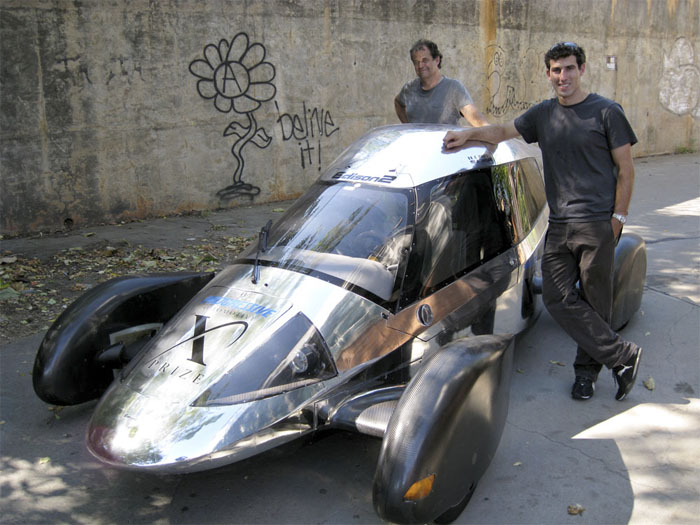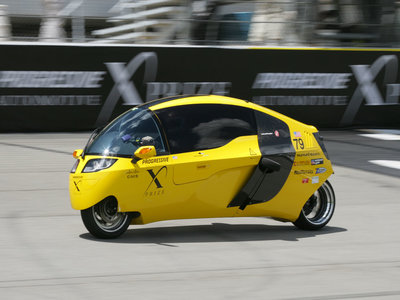September 16, 2010
By JOSHUA BROCKMAN
Oliver Kuttner and his team of designers have seen the future of fuel-efficient cars topping the dreamed-of mark of 100 miles per gallon. This week, the Edison2 team is being rewarded for its vision with half of the $10 million X Prize.
To get into the Edison2’s four-seater gas-powered vehicle, dubbed the Very Light Car, passenger and driver climb in through a window — just like a racecar. That might not be so easy for Grandma. But Kuttner, who’s 6-foot-4 and weighs 250 pounds, has no trouble jumping into the driver’s seat for a victory lap around Charlottesville, Va.
More than 100 competitors also jumped at the chance to compete for the Progressive Insurance Automotive X Prize.

Team Edison2’s Oliver Kuttner (left) and Brad Jaeger, one of the team’s professional race car drivers, with the Very Light Car that won the mainstream class of the X Prize competition. Joshua Brockman/NPR.
The prize will be shared among three teams: two from the United States and one from Switzerland. The honor is awarded to teams that create super-fuel-efficient vehicles with mainstream potential.
A Car You Can Push Around
The top prize-winning car is called the Very Light Car with good reason. It weighs just 840 pounds. You can push it with just a finger or two. The aerodynamic car looks like a futuristic egg suspended on four small wheels.
Kuttner says the car has just the basics.
“It has a heater. It has some basic ventilation. It accelerates briskly enough not to hold up traffic. But it’s just a modest car,” Kuttner says. But it does get over 100 mpg.
A Sneak Peek At The Winning Car
As Kuttner drives around the streets of Charlottesville, the car hugs corners and stops on a dime. But the real test for the competition occurred over the summer at the Michigan International Speedway. There, the team’s professional race car drivers ran it through safety tests used by Consumer Reports on mainstream cars.
“I think these cars are very much in their development stages,” says David Champion,Consumer Reports‘ director of automobile testing.
He says car engineers still need to iron out kinks with braking, emergency handling and acceleration.
“But they really showed the passion and the drive and the ingenuity of these engineers to produce these cars that were extremely fuel efficient,” Champion says.
Peter Diamandis, CEO of the X Prize Foundation, says the goal of the competition is to change what people want to drive.
“This is a prize to show the public that you can have a car that is beautiful, affordable, fast, safe and, ‘Oh by the way — it can get over 100 mpg or the gas equivalent.’ And why would you want anything else?”
Designing For Mass Appeal
Competitors had to demonstrate that their vehicles have mass appeal for consumers and mainstream automakers.
“So if anything is going to have an impact, it’s got to scale,” says Felix Kramer, the founder of CalCars, an advocacy group for plug-in hybrids. “And it’s got to reach the large automakers as well because it’s very rare that you get a new auto company coming in.”
Electrification
Kramer says most automakers are looking to bolster their fleets of electric cars — a trend that was certainly on display in the winner’s circle for the X Prize.
The other winning teams include X-Tracer from Switzerland and Li-ion Motors from Charlotte, N.C., which will get $2.5 million each for designing electric cars that won top prizes in the alternative category.
The X-Tracer’s vehicle, called the E-Tracer 7009, had the highest fuel efficiency rating in the competition, measuring an equivalent of more than 197 mpg, according to the official X Prize results. The car accommodates two passengers in a design that looks like a motorcycle with a cab on top of it.

Team X-Tracer from Switzerland will receive a $2.5 million X Prize for its E-Tracer 7009, which had the highest fuel efficiency rating in the competition — an equivalent of more than 197 mpg. Courtesy of X PRIZE Foundation
Team Li-ion’s Wave II two-seater also earned a high fuel efficiency rating — the equivalent of more than 171 mpg.
Carrying The Lessons Forward
Inside the Edison2 workshop in Lynchburg, Va., a production team of more than a dozen uses recyclable and low-cost materials to make the company’s cars.
“If we as a society want to use less energy, we must design cars that can be sold for, let’s say, $20,000 and deliver this unprecedented level of efficiency,” Kuttner says.
He says he thinks Edison2’s winning vehicle — the Very Light Car — could sell for this price if it ever reaches the mainstream market. That’s still a ways down the road. But their engines are revved up.
© NPR
